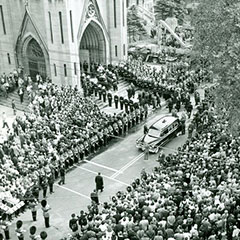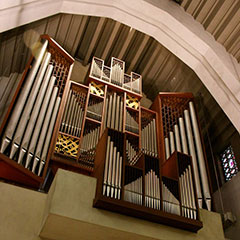Music and Funeral Rites
Music, be it secular or religious, is an important part of funeral rites. Giving access to a sacred realm, music echoes our emotions. It expresses what we can’t and elevates us to a state of grace. Schubert’s Ave Maria, often performed in such circumstances, is a great example of a solemn and timeless piece, a solace for the grieving soul. In this context, music makes us aware of our upset emotions and help voice our sorrow. Song lyrics are a way to convey the pain associated with the loss of a loved one.
The music selection for a funeral often reflects the deceased's tastes, or that of his or her family. It can also depend on the songs’ emotional charge. In the last few years, funerals have been more and more influenced by the departed’s life, to reflect who he or she was and to show how he or she touched those around him or her. Music can be seen as a message to the deceased or, inversely, can become a means for the deceased to communicate symbolically with the people in attendance. Either way, it is a way to pay tribute to the departed.
The Organ, King of Instruments
Each organ is unique, its tone being influenced by the organist’s personality and the acoustics of the church in which it stands. This instrument was invented in Egypt, around the third century B.C. Paradoxically, the invention’s initial purpose was not to make music, but to calculate mathematical ratios that generate sound. Nevertheless, over the course of time, and through different civilizations, the organ rapidly embraced its musical destiny. That being said, it was kept away from religious celebrations – which favoured vocals – until the 10th century. Organs were then built in churches, where they became a part of the service.
Some organ pieces are associated to funeral rites: Johann Sebastian Bach’s Fantasia in C minor, Guy Roparttz’s Prélude funèbre, or Maurice Duruflé’s Requiem, just to name a few.
Montreal Organs
Montreal, nicknamed “the city with a thousand steeples”, contains hundreds of organs. The city is known worldwide for its expertise in the field. Among the experts in the trade are Paul Jourdain, sculptor and cabinetmaker, Frenchman Jean-Baptiste Jacotel and American Samuel-Russel Warren. The last crafted more than 400 organs.
In 1879, the Casavant brothers launched their business. Quickly, they dominated the market, first in Quebec, then the whole of America. The Casavant name is still very well known today.
Ave Maria
Download audio (4 minutes 41 seconds, 4.31 MB)
Song performed on a piano accompanied by a female solo voice.
Composer: Franz Schubert
Original title: "Ellens Gesang III", D. 839, Op. 52, No. 6,1825
Source: Free sound bank
Hail Mary, full of grace,
Hail Mary, full of grace,
Hail, Hail, Lord,
The Lord is with thee.
Blessed art thou among women, and blessed is thee,
And blessed is the fruit of the womb,
Thy womb, Jesus.
Hail Mary!
Holy Mary, Mother of God,
Pray for us sinners,
Pray, pray for us;
Pray, pray for us sinners,
Now and at the hour of death,
In the hour of our death.
And at the hour, the hour of our death,
In the hour of our death.
Hail Mary!
Death
Download audio (2 minutes 37 seconds, 2.14 MB)
Piano music on the theme of death.
Source: Musée des Ursulines. Sound editor: Charles Lafontaine.
Musician: Ïoan Bastarache. Year: 2010
The theme was composed exclusively for the Trois-Rivières Musée des Ursulines’ “Du blanc au noir” exhibition soundtrack in 2010. This exhibition was part of a regional exhibition, which includes 20 other exhibitions on death (“La mort, des expositions à vivre”).
Alternative text: Piano music on the theme of death.




